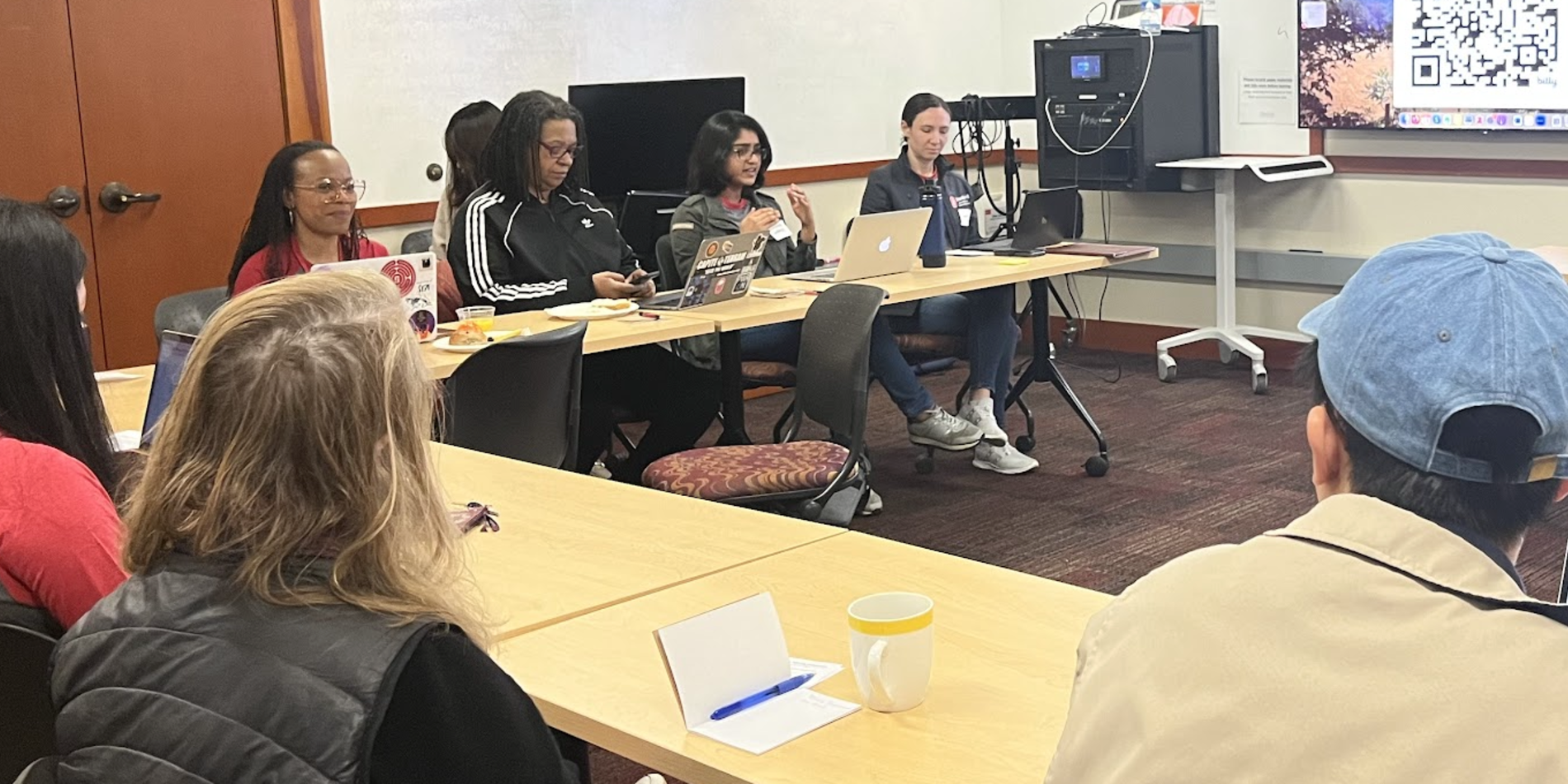Doesn’t it seem as if March 6, 2020 was millennium ago? Even Earth seems to be spinning faster than it used to. What began as perhaps a quarter’s worth of Zoom teaching and learning has stretched itself out across this whole year. Who knows when we will find our bearings back in the world of people, commutes, and classrooms.
This warping and stretching of time has been felt most acutely by our students as they Zoom in from all over the country and across the world. Students living in places as far from each other and Stanford as Rwanda, Kenya, London, Thailand, China, India, New Zealand, England, and Italy have been attending our classes and doing the best they can. PWR instructors’ care and commitment toward each student and their varying situations has manifested itself in particular ways for students impacted by the challenge of taking our classes in the dead of night. The students and instructors I interviewed and surveyed underlined both the intensity of the challenges posed by these gulfs in time zones as well as the inspiring adaptability and resilience of both teachers and students.
Instructors outlined some useful strategies that helped address the specific challenges posed by having students spread across the world in our Zoom classrooms. These strategies were numerous and included: meeting all students in advance of the quarter; noting PST after every deadline on the syllabus, encouraging students to annotate their syllabi with their own time-zones, and discussing the change in time difference after the U.S. clocks shifted into DST; offering flexibility with meeting times for office hours and conferences; reading email later into the night and early in the morning; creating cohorts in proximate time zones; and offering options for asynchronous work when a student ended up having to miss a class. As Sarah Pittock says, “The question I asked myself is how can I be compassionate and understand that they are exhausted but also make my teaching so engaging that it helps them get past their limitations and make their exhaustion worth it.”
Being in a constant state of sleep-deprivation, fatigue, and overall funk is the common theme across my conversations with Stanford students in distant time-zones. A student in my ESF-PWR 1 “Rebellious Minds” noted that “Daylight Savings Time threw my already fragile sleep-ecosystem off by another hour. Really, 2020!” Another student shared that what seemed the worst part of his experience was not being able to sleep regularly, as the times available for sleep differed across the different days depending on his class schedule and other meeting times. He said, “No matter how much you try, it’s impossible to fit everything and still be able to have a sleep schedule. Sleep-splitting didn’t work too well. The impact on me was trying to sleep and getting stressed about it. It also impacted my meals. Some days I only ate two meals because I forgot to eat or didn’t realize it was time to eat. My allergies got worse. I am taking a leave for Winter quarter so I can just be normal for a while.” Thus, for several students learning in such excruciatingly difficult time zones was not sustainable.
Instructors and students also reported that having students all over the global map resulted in the world seeping into the classroom in unprecedented ways. Curfew in Nairobi, protests in Thailand, new lockdowns in Italy, a typhoon in the Philippines, an internet outage in Rwanda, getting delayed on the way back from a protest march in D.C., a fire on a reservation all impacted our students and became topics of informal conversations in class. Nikita Tan, a student in my class who flew into Stanford from England in Week 6, found a huge cheering squad for her journey in her Zoom classroom as well as over Group.Me and Instagram. But not all was peaches and cream. An instructor who normally teaches a short lesson about rhetoric and censorship and uses examples from China felt very uncomfortable using the same materials and examples they had a student who was a senior Chinese bureaucrat’s daughter. Also, especially as the U.S. election and recent political developments have been on the top of many U.S.-based students’ minds, instructors underlined the need to be mindful of the students in the classroom who would have a harder time entering or even fully understanding these conversations. As Sarah Pittock observes, “I needed to be sensitive to the fact that some of my international students would be lost in discussions of RBG and Breonna Taylor and I would need to translate these American dilemmas and controversies for these students.”
The Hume Center for Writing and Speaking as well as Stanford Libraries have been amazing partners to PWR students and instructors in facilitating pandemic-era teaching and learning. International students in particular benefited from the early and late hours offered by Hume. Stanford Libraries made a big effort to have more material digitally available. Assistant Director of Hume Norah Fahim, who was leading a Fall Writing Circle there, described how students faced the challenges posed by time zone differences with remarkable adaptability and resilience. Fahim says, “My international students were upbeat despite being tired. They were in class rain or shine, online, full of questions, curious, never lost---tired but still invested. I’m very proud of what they have done in spite of everything that is going on.”
Through it all, PWR instructors underscored the importance of compassion, conversation, community and flexibility for each student no matter their geographical location. As Harriet Jernigan observes, “You don’t have to be halfway around the world to be dealing with difficulties. We are also supporting the student who has to constantly translate for her grandfather on a reservation, the student getting over the suicide of their best friend, those that are underrepresented and underserved, regardless of time zone.”
Here were some other instructor and student comments
Anonymous
The most difficult aspect was the fatigue students clearly felt. Those with twelve-hour time differences were convinced that they could handle the demands, but they ultimately could not without great cost to their health and well-being. One of these students went MIA citing stresses. Another student developed COVID-19, and I made the choice to hold a separate, one-on-one class for the last two weeks so this student could complete the coursework. I wouldn't recommend my accommodation; it would be an unfair burden to expect what simply isn't reasonable labor. If I had any say, I would not permit students to select courses that begin for them after 10pm in their time zone.”
Nissa Cannon
Students had all opted in to the class times, so everyone was prepared to deal with those. The challenge on my side was making sure my office hours and conference slots included options that those on different time zones were able to access. It seemed like the regularly-scheduled stuff was easy for everyone to keep track of, but for the one-off meetings there was more confusion/missed meetings than normal, as students sometimes forgot to adjust times for their own calendars.
Holly Fulton
I emphasized to students individually that I'm happy to flex conference times and semi-synchronous activities (like Slack) to accommodate their time difference; asking students in distant time zones to check in with me so we can identify potential challenges; emphasizing to students that I’m willing to (and have no problem) ‘meeting them halfway’ seemed to really put them at ease, which has a benefit in and of itself. Also, normalizing the geographic diversity among my students seemed to help.
Kevin Moore
Most students seem to know how to automatically translate due dates and conference times to their own time-zones. But it did enter my mind as an emerging (albeit sci-fi bizarre) equity issue: whose time zone is the most important? While we remain centered on the time zone of the physical campus, one can potentially imagine a scenario where we might adopt some kind of standardized global time for some situations.
Maxwell Ojiambo, Freshman in Nairobi, Kenya
The 10-hour time difference meant that all my classes were at night, so the plan initially was to sleep during the day and work during the night. But the workload was bigger than i expected so i ended up working during the day and the better part of the night so for most nights I got like 5 or 6 hours of sleep. I had spent some time in LSP learning to converse with people that were not necessarily Kenyan so I had a bit of head-start. When the quarter began I was taking a class about communicating in the US, but when I saw the amount of speaking that we did in my ESF-PWR class I decided to drop it.
John Peterson
Distance and isolation were hard on everyone in the class. And the time differences for international students disrupted their lives in many ways. That being said, my student from Nairobi showed remarkable adaptability in facing the many challenges of distance learning and time zone difference. Dealing with a city-wide curfew was just one example of how many complications he was dealing with.
Ruth Starkman
I seem to give a lot more hours than before, but as an empty-nester and now with the relief of no-commute, have no trouble making early or late times to meet my students. I'm sure the younger parents have a lot more on their hands than I do, please let me know how I can help.
Jonah Willihnganz
It was helpful to make sure students over the date line were clear about their due dates/times, especially for assignments that would be workshopped.
Roberta Wolfson
Typically, by the night before a scheduled conference, I would email my students written feedback on their paper drafts and ask them to review the feedback before our meeting time. All of my students were able to review my feedback before we met, except for this one student living in China, because she would be sleeping when I sent her my feedback and wouldn't have time to review it before she needed to meet with me. So that meant she didn't have the benefit (unlike all of her other classmates) of being able to digest my feedback independently and then ask questions about my feedback during our conference meeting. In future quarters, if I face a similar challenge, I think I will make a concerted effort to review my international students' papers at least 2 days in advance (rather than 1 day in advance) so that I can give them more time to read my written feedback before our conference meeting.
Also, if I could give one piece of advice to instructors dealing with similar challenges in Winter and Spring it would be that we should strive to be flexible and understanding with students who are living in non-PST time zones, since challenges will inevitably arise and the students will greatly appreciate our compassion in those tricky circumstances!



